Which Line Segments Do You Draw To Find The Center Of A Circle Circumscribed About A Triangle
two.five: Confining and Inscribed Circles
- Page ID
- 3258
Retrieve from the Constabulary of Sines that whatsoever triangle \(\triangle\,ABC\) has a common ratio of sides to sines of opposite angles, namely
\[\nonumber
\frac{a}{\sin\;A} ~=~ \frac{b}{\sin\;B} ~=~ \frac{c}{\sin\;C} ~.
\]
This common ratio has a geometric meaning: information technology is the diameter (i.eastward. twice the radius) of the unique circle in which \(\triangle\,ABC\) tin be inscribed, called the circumscribed circle of the triangle. Before proving this, we demand to review some elementary geometry.

An inscribed angle of a circle is an angle whose vertex is a point \(A\) on the circle and whose sides are line segments (called chords) from \(A\) to two other points on the circumvolve. In Figure 2.5.1(b), \(\angle\,A\) is an inscribed bending that intercepts the arc \(\overparen{BC} \). We state hither without proof a useful relation between inscribed and central angles:
Theorem 2.4
If an inscribed angle \(\angle\,A\) and a central bending \(\angle\,O\) intercept the same arc, then \(\angle\,A = \frac{1}{2}\,\angle\,O\, \). Thus, inscribed angles which intercept the same arc are equal.
Effigy ii.5.one(c) shows two inscribed angles, \(\angle\,A\) and \(\angle\,D \), which intercept the aforementioned arc \(\overparen{BC}\) equally the key angle \(\angle\,O \), and hence \(\angle\,A = \angle\,D = \frac{1}{2}\,\angle\,O\) (so \(\;\bending\,O = 2\,\angle\,A = 2\,\angle\,D\,) \).
We will now prove our assertion well-nigh the common ratio in the Law of Sines:
Theorem 2.5
For whatever triangle \(\triangle\,ABC \), the radius \(R\) of its circumscribed circle is given by:
\[2\,R ~=~ \frac{a}{\sin\;A} ~=~ \frac{b}{\sin\;B} ~=~ \frac{c}{\sin\;C}\label{2.35}\]
Note: For a circumvolve of bore \(1 \), this means \(a=\sin\;A \), \(b=\sin\;B \), and \(c=\sin\;C \).)
To prove this, permit \(O\) be the middle of the confining circumvolve for a triangle \(\triangle\,ABC \). Then \(O\) tin can be either inside, outside, or on the triangle, as in Figure two.5.ii below. In the commencement two cases, describe a perpendicular line segment from \(O\) to \(\overline{AB}\) at the betoken \(D \).
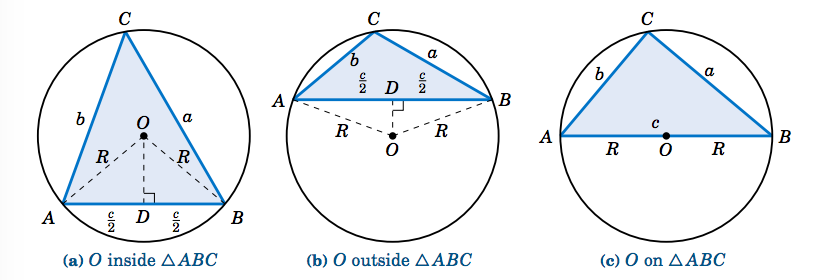
The radii \(\overline{OA}\) and \(\overline{OB}\) have the aforementioned length \(R \), then \(\triangle\,AOB\) is an isosceles triangle. Thus, from elementary geometry we know that \(\overline{OD}\) bisects both the angle \(\angle\,AOB\) and the side \(\overline{AB} \). So \(\bending\,AOD = \frac{1}{2}\,\angle\,AOB\) and \(Ad = \frac{c}{2} \). But since the inscribed angle \(\bending\,ACB\) and the key angle \(\angle\,AOB\) intercept the same arc \(\overparen{AB} \), we know from Theorem ii.iv that \(\bending\,ACB = \frac{ane}{two}\,\angle\,AOB \). Hence, \(\angle\,ACB = \angle\,AOD \). So since \(C =\angle\,ACB \), we have
\[\nonumber
\sin\;C ~=~ \sin\;\bending\,AOD ~=~ \frac{Ad}{OA} ~=~ \frac{\frac{c}{ii}}{R} ~=~ \frac{c}{2R}
\quad\Rightarrow\quad 2\,R ~=~ \frac{c}{\sin\;C} ~,
\]
so by the Law of Sines the effect follows if \(O\) is inside or outside \(\triangle\,ABC \).
At present suppose that \(O\) is on \(\triangle\,ABC \), say, on the side \(\overline{AB} \), as in Figure 2.five.ii(c). Then \(\overline{AB}\) is a diameter of the circle, and so \(C = ninety^\circ\) by Thales' Theorem. Hence, \(\sin\;C = 1 \), and so \(two\,R = AB = c = \frac{c}{1} = \frac{c}{\sin\;C}\; \), and the outcome again follows by the Law of Sines. QED
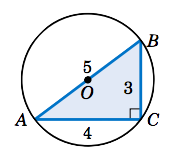
Solution:
We know that \(\triangle\,ABC\) is a right triangle. And so as nosotros see from Figure ii.5.3, \(\sin\;A = iii/5 \). Thus,
\[ ii\,R ~=~ \frac{a}{\sin\;A} ~=~ \frac{3}{\frac{3}{five}} ~=~ 5 \quad\Rightarrow\quad \boxed{R ~=~ ii.5} ~.\nonumber \]
Note that since \(R =ii.5 \), the diameter of the circle is \(five \), which is the same as \(AB \). Thus, \(\overline{AB}\) must exist a bore of the circle, and so the center \(O\) of the circle is the midpoint of \(\overline{AB} \).
Corollary 2.6
For any correct triangle, the hypotenuse is a diameter of the circumscribed circumvolve, i.e. the centre of the circle is the midpoint of the hypotenuse.
For the right triangle in the in a higher place example, the circumscribed circle is simple to draw; its centre can be institute by measuring a distance of \(ii.five\) units from \(A\) along \(\overline{AB} \).
Nosotros need a different process for acute and obtuse triangles, since for an acute triangle the center of the confining circle will exist inside the triangle, and information technology volition exist exterior for an obtuse triangle. Notice from the proof of Theorem 2.5 that the center \(O\) was on the perpendicular bisector of 1 of the sides (\(\overline{AB}\)). Similar arguments for the other sides would show that \(O\) is on the perpendicular bisectors for those sides:
Corollary ii.vii
For any triangle, the center of its circumscribed circle is the intersection of the perpendicular bisectors of the sides.
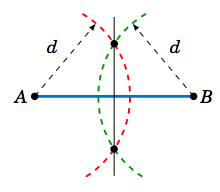
Example 2.18
Observe the radius \(R\) of the confining circle for the triangle \(\triangle\,ABC\) from Example ii.half dozen in Section 2.2: \(a = 2 \), \(b = 3 \), and \(c = 4 \). Then draw the triangle and the circle.
Solution:
In Example 2.6 we found \(A=28.9^\circ \), and so \(2\,R = \frac{a}{\sin\;A} = \frac{two}{\sin\;28.9^\circ} = four.14 \), so \(\boxed{R = ii.07}\; \).
In Figure ii.v.5(a) we prove how to draw \(\triangle\,ABC\): use a ruler to draw the longest side \(\overline{AB}\) of length \(c=4 \), then use a compass to draw arcs of radius \(three\) and \(2\) centered at \(A\) and \(B \), respectively. The intersection of the arcs is the vertex \(C \).

In Effigy 2.5.5(b) we show how to draw the circumscribed circle: draw the perpendicular bisectors of \(\overline{AB}\) and \(\overline{AC}\); their intersection is the middle \(O\) of the circle. Use a compass to depict the circumvolve centered at \(O\) which passes through \(A \).
Theorem 2.5 tin can be used to derive some other formula for the expanse of a triangle:
Theorem two.eight
For a triangle \(\triangle\,ABC \), allow \(M\) be its area and allow \(R\) be the radius of its confining circle. So
\[K ~=~ \frac{abc}{4\,R} \quad ( \text{and hence }\; R ~=~ \frac{abc}{4\,One thousand} ~) ~. \label{2.36}\]
To evidence this, note that by Theorem 2.v we have
\[\nonumber
two\,R ~=~ \frac{a}{\sin\;A} ~=~ \frac{b}{\sin\;B} ~=~ \frac{c}{\sin\;C} \quad\Rightarrow\quad
\sin\;A ~=~ \frac{a}{ii\,R} ~,~~ \sin\;B ~=~ \frac{b}{2\,R} ~,~~ \sin\;C ~=~ \frac{c}{ii\,R} ~.
\]
Substitute those expressions into Equation ii.26 from Section 2.4 for the expanse \(K\):
\[\nonumber
K ~=~ \frac{a^2 \;\sin\;B \;\sin\;C}{2\;\sin\;A} ~=~
\frac{a^2 \;\cdot\; \frac{b}{2\,R} \;\cdot\; \frac{c}{2\,R}}{2\;\cdot\; \frac{a}{2\,R}}
~=~ \frac{abc}{4\,R} \qquad \textbf{QED}
\]
Combining Theorem 2.8 with Heron's formula for the area of a triangle, we get:
Corollary ii.9
For a triangle \(\triangle\,ABC \), permit \(s = \frac{1}{2}(a+b+c) \). Then the radius \(R\) of its confining circle is
\[R ~=~ \frac{abc}{four\,\sqrt{southward\,(s-a)\,(due south-b)\,(s-c)}} ~~.\label{2.37}\]
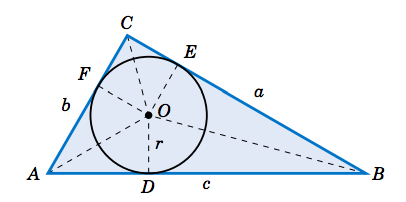
Let \(r\) exist the radius of the inscribed circumvolve, and let \(D \), \(E \), and \(F\) be the points on \(\overline{AB} \), \(\overline{BC} \), and \(\overline{AC} \), respectively, at which the circle is tangent. And so \(\overline{OD} \perp \overline{AB} \), \(\overline{OE} \perp \overline{BC} \), and \(\overline{OF} \perp \overline{AC} \). Thus, \(\triangle\,OAD\) and \(\triangle\,OAF\) are equivalent triangles, since they are right triangles with the aforementioned hypotenuse \(\overline{OA}\) and with respective legs \(\overline{OD}\) and \(\overline{OF}\) of the same length \(r \). Hence, \(\angle\,OAD =\angle\,OAF \), which means that \(\overline{OA}\) bisects the angle \(A \). Similarly, \(\overline{OB}\) bisects \(B\) and \(\overline{OC}\) bisects \(C \). Nosotros have thus shown:
For any triangle, the center of its inscribed circumvolve is the intersection of the bisectors of the angles.
Nosotros volition use Effigy 2.v.6 to find the radius \(r\) of the inscribed circle. Since \(\overline{OA}\) bisects \(A \), we come across that \(\tan\;\frac{one}{2}A = \frac{r}{Advert} \), and so \(r = AD \,\cdot\, \tan\;\frac{1}{2}A \). Now, \(\triangle\,OAD\) and \(\triangle\,OAF\) are equivalent triangles, and so \(AD =AF \). Similarly, \(DB = EB\) and \(FC = CE \). Thus, if we let \(due south=\frac{1}{2}(a+b+c) \), we see that
\[\nonumber\begin{marshal*}
two\,s ~&=~ a ~+~ b ~+~ c ~=~ (AD + DB ) ~+~ (CE + EB) ~+~ (AF + FC)\\ \nonumber
&=~ AD ~+~ EB ~+~ CE ~+~ EB ~+~ AD ~+~ CE ~=~ 2\,(Advertizing + EB + CE)\\ \nonumber
s ~&=~ AD ~+~ EB ~+~ CE ~=~ Ad ~+~ a\\ \nonumber
AD ~&=~ s - a ~.
\end{marshal*}\]
Hence, \(r = (due south-a)\,\tan\;\frac{1}{ii}A \). Like arguments for the angles \(B\) and \(C\) give us:
Theorem 2.10
For any triangle \(\triangle\,ABC \), let \(s = \frac{1}{2}(a+b+c) \). And so the radius \(r\) of its inscribed circle is
\[ r ~=~ (south-a)\,\tan\;\tfrac{1}{ii}A ~=~ (s-b)\,\tan\;\tfrac{i}{two}B ~=~
(southward-c)\,\tan\;\tfrac{1}{two}C ~.\characterization{two.38}\]
We also come across from Figure 2.five.half dozen that the area of the triangle \(\triangle\,AOB\) is
\[\nonumber
\text{Area}(\triangle\,AOB) ~=~ \tfrac{1}{2}\,\text{base} \times \text{height} ~=~
\tfrac{1}{2}\,c\,r ~.
\]
Similarly, \(\text{Expanse}(\triangle\,BOC) = \frac{i}{two}\,a\,r\) and \(\text{Area}(\triangle\,AOC) = \frac{1}{2}\,b\,r \). Thus, the surface area \(1000\) of \(\triangle\,ABC\) is
\[\nonumber \brainstorm{align*}
K ~&=~ \text{Area}(\triangle\,AOB) ~+~\text{Area}(\triangle\,BOC) ~+~ \text{Area}(\triangle\,AOC)
~=~ \tfrac{ane}{2}\,c\,r ~+~ \tfrac{1}{2}\,a\,r ~+~ \tfrac{1}{2}\,b\,r\\ \nonumber
&=~ \tfrac{1}{two}\,(a+b+c)\,r ~=~ sr ~,~\text{so by Heron'southward formula we get}\\ \nonumber
r ~&=~ \frac{K}{s} ~=~ \frac{\sqrt{southward\,(s-a)\,(s-b)\,(s-c)}}{s} ~=~
\sqrt{\frac{s\,(south-a)\,(due south-b)\,(southward-c)}{southward^two}} ~=~ \sqrt{\frac{(s-a)\,(south-b)\,(s-c)}{s}} ~~.
\end{align*}\]
We take thus proved the following theorem:
Theorem 2.11
For whatsoever triangle \(\triangle\,ABC \), let \(southward = \frac{ane}{2}(a+b+c) \). And then the radius \(r\) of its inscribed circumvolve is
\[\label{2.39}r ~=~ \frac{Chiliad}{s} ~=~ \sqrt{\frac{(s-a)\,(s-b)\,(s-c)}{southward}} ~~.\]
Recall from geometry how to bisect an angle: utilize a compass centered at the vertex to draw an arc that intersects the sides of the angle at 2 points. At those ii points use a compass to describe an arc with the same radius, large plenty so that the two arcs intersect at a betoken, equally in Figure 2.five.vii. The line through that point and the vertex is the bisector of the angle. For the inscribed circle of a triangle, you need simply two angle bisectors; their intersection will be the middle of the circle.
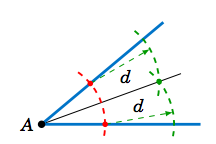
Example ii.19
Find the radius \(r\) of the inscribed circumvolve for the triangle \(\triangle\,ABC\) from Instance 2.vi in Section 2.two: \(a = two \), \(b = 3 \), and \(c = iv \). Draw the circle.
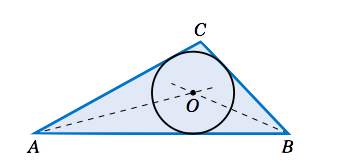
Figure 2.5.8
Solution:
Using Theorem 2.11 with \(south = \frac{ane}{two}(a+b+c) =\frac{1}{two}(2+iii+four) = \frac{ix}{ii} \), we have
\[ r ~=~ \sqrt{\frac{(s-a)\,(s-b)\,(south-c)}{s}} ~=~
\sqrt{\frac{\left(\frac{9}{2}-2\correct)\,\left(\frac{9}{2}-iii\correct)\,\left(\frac{ix}{2}-
4\right)}{\frac{9}{2}}} ~=~ \sqrt{\frac{5}{12}}~.\nonumber \]
Effigy ii.5.eight shows how to describe the inscribed circumvolve: draw the bisectors of \(A\) and \(B \), so at their intersection use a compass to depict a circumvolve of radius \(r = \sqrt{5/12} \approx 0.645 \).
Source: https://math.libretexts.org/Bookshelves/Precalculus/Book%3A_Elementary_Trigonometry_(Corral)/02%3A_General_Triangles/2.05%3A_Circumscribed_and_Inscribed_Circles
Posted by: caballeroarriess.blogspot.com


0 Response to "Which Line Segments Do You Draw To Find The Center Of A Circle Circumscribed About A Triangle"
Post a Comment